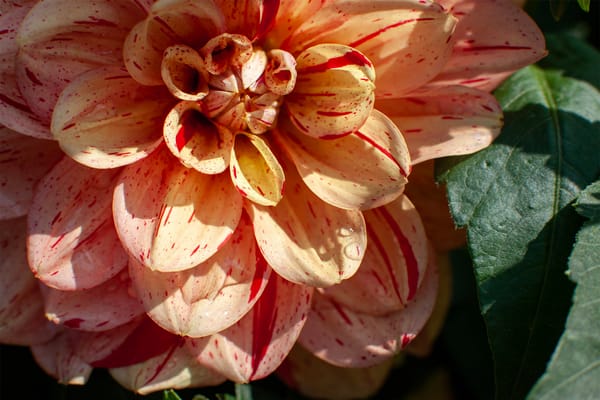Understanding Disease, Pests, and Nature-Friendly Solutions for Resilient Blooms
There’s a particular magic to a Cornish summer garden — the soft mist rolling in from the coast, the heavy, rain-soaked air that clings to the leaves, and the dahlias standing tall in the border, defiant in their brightness. But as any seasoned gardener knows, this same damp climate that feeds lush growth also quietly invites trouble.
In Cornwall, where Atlantic rains can arrive overnight and linger for days, wet weather plays a powerful—and often underestimated—role in the health of garden plants. Nowhere is this more apparent than with dahlias, a flower as beloved for its flamboyant blooms as it is notorious for attracting disease in damp conditions.
This is the story of how wet weather shapes the fate of dahlias — and how thoughtful gardeners can work with nature, not against it, to protect these floral icons.
The Double-Edged Sword of Rain: How Wet Weather Fuels Dahlia Diseases
The Perfect Storm for Fungal and Bacterial Invaders
When moisture lingers on leaves and soil remains saturated, it sets the stage for opportunistic pathogens to thrive. Some, like Botrytis cinerea — better known as grey mold — only need a damp, airless corner to settle in.
In a typical Cornish summer, the recipe is perfect: soft rain, little wind, and humid mornings where petals never quite dry. Buds darken before they open, cloaked in a fuzzy grey mold that can sweep through a border within days. Left unchecked, Botrytis devastates flowering potential, especially in overplanted or poorly ventilated areas.
Powdery mildew, though often thought of as a dry-weather disease, can also surge in damp air—especially when plants remain wet overnight. Unlike Botrytis, which attacks decaying or older tissue, powdery mildew strikes young, growing foliage, coating leaves in a ghostly white film that saps energy and ruins display.
Then there’s Dahlia Smut (Entyloma dahliae) — a less dramatic but no less harmful fungal disease. It leaves pale blotches and brown lesions across the leaves, often spreading via rain-splash from the soil or by overhead watering. In seasons of frequent rain, smut can quietly suppress plant vigor and make dahlias look tired and lacklustre before their time.
But perhaps most feared among growers is stem and tuber rot — a soft, bacterial or fungal-driven decay that sets in when soils become waterlogged. Once this rot takes hold, the plant's tissues collapse into a soggy mess, accompanied by the unmistakable sour smell of decay. With tuber rot, there is no second chance; infected plants must be removed entirely.
The Hidden Highways of Disease: Water, Overcrowding, and Pest Vectors
It’s not just moisture itself but its movement through the garden that amplifies disease spread. Water doesn’t respect boundaries — it splashes from leaf to leaf, plant to plant, carrying fungal spores, bacteria, and even microscopic pests.
Heavy rain or careless overhead watering can spread infections across a bed in hours. In dense plantings, where leaves press against each other, this effect is multiplied. Crowding also slows the drying process, keeping conditions damp for longer and giving diseases more time to take hold.
Even viruses, often carried by sap-feeding insects like aphids or thrips, find an indirect ally in wet weather. Lush, succulent growth triggered by damp conditions offers easy feeding grounds for pests—and soft, vulnerable entry points for viral infections. The rain may not bring the virus itself, but it paves the way for the insects that do.
The Unsung Culprits: Slugs, Snails, and the Damp-Loving Pests
Walk through a Cornish garden after rain, and you’ll often find the telltale trails: silvery lines weaving between dahlia stems, petals nibbled at the edges, new shoots stripped overnight.
Slugs and snails thrive in the damp — and though their damage may seem cosmetic at first, it weakens plants, opens wounds for infections, and, in the case of young dahlias, can entirely destroy a season’s hopes.
Add in earwigs sheltering in flower heads, thrips rasping at leaves, and aphids clustering on soft new shoots, and the challenge of damp-weather pest management becomes clear.
A Gardener’s Defence: Nature-Friendly Strategies for a Wetter World
Start with Space, Airflow, and Drainage
The first line of defence is not chemical — it’s structural. Give dahlias space to breathe. Plant generously apart, even when it feels against instinct in a lush border. Space encourages airflow, which dries foliage faster after rain and limits fungal spread.
Raised beds or mounded planting areas allow for better drainage, preventing waterlogged soil that invites tuber rot. In wetter areas, consider container growing with free-draining compost mixes.
Clean Gardening and Timely Intervention
Good hygiene is a quiet but powerful ally.
- Remove spent blooms and fallen leaves before they become fungal footholds.
- Cut out infected material at the first sign — and dispose of it, never compost it.
- Disinfect tools regularly, especially after pruning affected plants.
Morning watering at the base of the plant — never overhead — keeps foliage dry while providing needed moisture.
Organic Pest Control: Working with, Not Against, Nature
Slugs and snails can be deterred with simple barriers like sheep’s wool pellets, which double as a soil conditioner, or copper tape for pots and containers. Beer traps and evening hand-picking sessions — though old-fashioned — remain remarkably effective.
For aphids, thrips, and mites, neem oil sprays offer a natural deterrent that disrupts pest life cycles without harming beneficial insects when applied carefully. Companion planting — like surrounding dahlias with marigolds, nasturtiums, lavender, and dill — confuses pests and invites natural predators like ladybirds and lacewings.
Integrated Pest Management (IPM) embraces a balanced, multi-layered strategy:
- Prevention through healthy soil, plant selection, and garden hygiene
- Monitoring with regular, close-up inspections
- Physical barriers, traps, and natural predators before resorting to treatments
- Targeted use of organic products when absolutely necessary
IPM isn’t about creating a pest-free garden — it’s about maintaining a healthy balance where pests exist in low enough numbers that they do no serious harm. A few nibbled leaves or an occasional aphid cluster is part of a living, biodiverse system.
Companion Planting: A Living Shield for Your Dahlias
Companion planting adds a layer of resilience and beauty. Aromatic herbs like rosemary, sage, and chives deter pests and thrive in similar conditions. Flowers like yarrow, calendula, and cosmos not only draw in beneficial insects but fill out borders with colour and movement.
By planting with diversity in mind, you create a garden that is harder for pests and diseases to overwhelm — and richer in life overall.
Embracing the Weather, Not Fighting It
In Cornwall, wet weather isn’t a problem to be solved — it’s a reality to be understood. By recognising how rain, humidity, and water movement affect plant health, gardeners can make informed, respectful choices that work with the environment rather than against it.
From better airflow to natural pest partnerships, every action contributes to a healthier, more resilient garden. The goal isn’t perfection but balance — a garden where dahlias bloom with vigour amid a living, thriving ecosystem.
In the End: A Story of Vigilance and Harmony
Dahlias may ask more of the gardener than some summer flowers, especially in a wet Cornish season. But they reward care with unforgettable beauty. Managing disease and pests doesn’t have to mean constant intervention. Instead, it’s about observation, understanding, and a few well-chosen practices that align with nature’s rhythms.
In this way, even in the wettest summers, the dahlia stands not just as a symbol of the gardener’s art—but of nature’s capacity for resilience and renewal.
Summary . . .
| Factor/Issue | Risk or Impact | Recommended Action |
|---|
| Botrytis (Grey Mold) | Bud blight, petal rot in damp conditions | Remove infected parts, improve airflow |
| Powdery Mildew | White leaf coating in humid air | Space plants, water at base, prune |
| Dahlia Smut | Leaf lesions, spread via splash | Mulch carefully, avoid overhead water |
| Stem & Tuber Rot | Rapid decay in waterlogged soils | Ensure drainage, grow in raised beds |
| Slugs & Snails | Chew foliage, spread disease | Use barriers, traps, hand collect |
| Aphids/Thrips | Pest damage, virus vectors | Neem oil, encourage beneficial insects |
| Overcrowding | Increases disease spread | Space plants, thin regularly |
| Water Splash | Spreads spores & bacteria | Water at base, avoid splash |
| IPM (Integrated Approach) | Sustainable pest & disease management | Monitor, prevent, use organic controls |
| Companion Planting | Supports beneficial insects, deters pests | Mix aromatic herbs & insectary plants |











